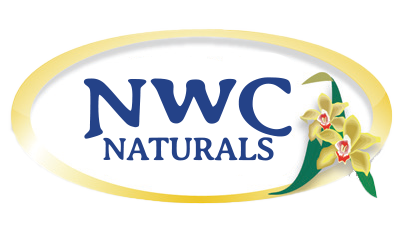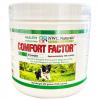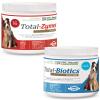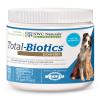Enzymes for Athletic Injuries
Current Practices
One of the most widely recognized problems in rehabilitation therapeutics is the need for an effective non-toxic aid to control inflammation caused by athletic injuries. The ideal therapeutic aid in such cases should accelerate both the rate of recovery from the injury and the reduction of the pain phase of the inflammatory process which results from the tissue damage of the injury.
In current sports injury therapeutics, the most popular aids to recovery are non-steroidal, anti-inflammatory drugs (NSAID). By inhibiting various natural physiological mechanisms, these NSAID agents tend to reduce the immediate inflammatory response and, thus allow the athlete to enter a physical therapy program more rapidly. However. there are some serious concerns over the current widespread use of NSAIDs, including serious gastrointestinal side effects (The common saying among athletes is "those pills tear up your stomach.") and the very real possibility that by inhibiting natural physiological processes, the NSAIDs actually slow down recovery from injury.
An Attractive alternative
Of increasing current interest in sports medicine are the possibilities offered by Proteolytic enzymes to accelerate the recovery process.
Proteolytic enzymes, offer a possible alternative to the present extensive use of NSAIDs. The mode of action of these enzymatically active agents appears to be that they rapidly hydrolyze the waste products which collect in the injured tissue, and thus facilitate both removal of these waste products and improved access of natural healing agents to the tissue. There are a number of inherent advantages afforded by this approach including:
(1) proteolytic enzymes tend to enhance, rather than suppress, physiological mechanisms, thus, improving the possibility of true recovery from the injury.
(2) except for pre-existing conditions, such as ulcer or gastritis, proteolytic enzymes do not produce negative gastrointestinal side effects (by enhancing protein digestion, they may actually be beneficial to the GI tract),
(3) enzymes in general, are rapidly degraded and thus, do not pose a threat in terms of long-term toxic build-up
European Practices
Proteolytic enzymes have been investigated for several decades. In spite of this the progress of the investigation and use if this very promising approach in the United States has been very slow, although isolated reports from several investigators have been generally highly favorable. It is suspected by many observers that this slow progress may have much more to do with economics than efficacy. Since the proteolytic enzymes generally fall into the category of naturally-occurring substances for which it is difficult to obtain patents and thereby, achieve market protection. This makes for an unattractive situation for pharmaceutical firms, which are the most frequent sponsors of medical research into new therapeutic agents.
However this has not been the case in Europe, where the conditions under which the medical community operates are considerably different. In European Countries, particularly Germany, the use of enzymes as anti-inflammatory agents is very prevalent, especially in applications involving sports injuries. Scientific investigation of the use of enzymes as aids to recovery from sports injures has been very active as well.
Bruise Healing
For example, Dr. M. W. KIeme and his co-workers at the Sports Medicine investigation Center in Grunwald, Germany conducted a study of the effectiveness of proteolytic, enzymes on 100 athletes. In this study, two cubic centimeters of blood were removed from the anticubital vein of each subject and injected under the skin of the inside of the right forearm to artificially produce a hematoma. Half of the subjects then took anti-inflammatory enzymes and half took a placebo, each three times daily. The results were measured in terms of amount of pain, pain caused by pressure, and rapidity of disappearance of the hematoma.
The findings were convincing. The success rate was evaluated as' "good" by 76% of the enzyme-treated subjects, and by only 14% of those treated with a placebo. In other words, the enzyme-treated subjects felt less pain, less pain on pressure, the pain caused by pressure disappeared sooner, and the visible hematoma disappeared much sooner.
Injury Prevention
In another double blind study involving preventive treatment, 20 karate fighters were divided into groups of ten each, with one group receiving enzymes and the other a placebo. After each subject had engaged in competition during which they received bruises, each was examined daily to determine the healing rate of the bruises.
The results were impressive. The athletes treated proplylactically with enzymes suffered hematomas which disappeared within seven days, while the athletes who received no enzymes required 16 days for the same results.
Surgery Preparation and Recovery
In another study on the use of enzymes to treat the effects of injuries, a surgeon who specializes in the removal of torn meniscus tissue from injured knee joints conducted a double-blind study in which a group of his patients received enzymes before surgery to reduce swelling. A matching group was given a placebo the average time required for the subsidence of swelling in preparation for surgery' for the enzyme-treated group was 17 days. while the placebo group required 24 days for the swelling to subside sufficiently to perform surgery.
Enzyme treatment also had a beneficial effect on post-surgery recovery time. The hospital stay following surgery averaged eight days for enzyme-treated patients, while the average hospital stay for the patients without enzymes was 14 days.
Growing Acceptance
As a result of these and many other clinical studies on using enzyme preparations as an aid in preventing and healing injuries. the interest in this powerful non-toxic method of treatment is growing. This approach holds great promise for athletes, especially those who are involved in injury-sensitive contact sports.
The most advanced proteolytic enzyme preparation currently available is MSM Gold®, introduced in 1998 by NWC Naturals™. Using the experience of several decades of enzyme technology as well as state-of-the-art nutrient delivery systems, MSM Gold® achieves even more impressive and dependable results than previous enzyme formulas. The widespread use of this cutting-edge enzyme formula promises to deliver a new level of safe relief from athletic injuries, as well as many other forms of trauma.
References
1 Lie. KK. et al. Therapeutic a value of oral proteolytic enzymes following hand surgery. Aran Surgery, 96103 (1961).
2 Boyne PS and Medhurst, H "Oral anti-inflammatory enzyme therapy in professional footballers. "The Pracitoner", 1948 : 543 (1967).
3 Detric. R E. "Oral proteolytic a enzymes n the treatment of athletic injuries; a double-blind study." The Penn Med. J.68:35 (1965).
4. Woolf, RM, "Resolution of an artificially induced hematoma and the influence of a proteolytic enzyme" J Trauma, 5:491(1965).
5. Sherr S. and Fletcher. A.P., "Proteolytic enzymes: a therapeutic evaluation." Olin. Pharmacology and Therapeutics 1:202(1961).
6. kleine. M.W... Vogler W "The effects of an oral enzyme treatment on experimentally induced hematomas Forum Ceo Pract. 2:27(1968)
7. Zuschlag. H Study reported by Lopez. 0 A., et. al. in Enzymes, The Fountain Of Life Neville Press. Charleston. SC, USA (1994)










